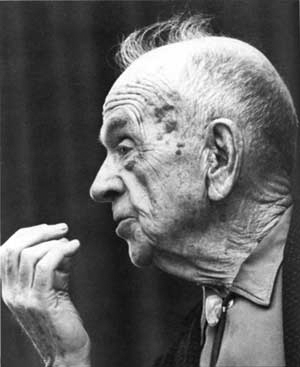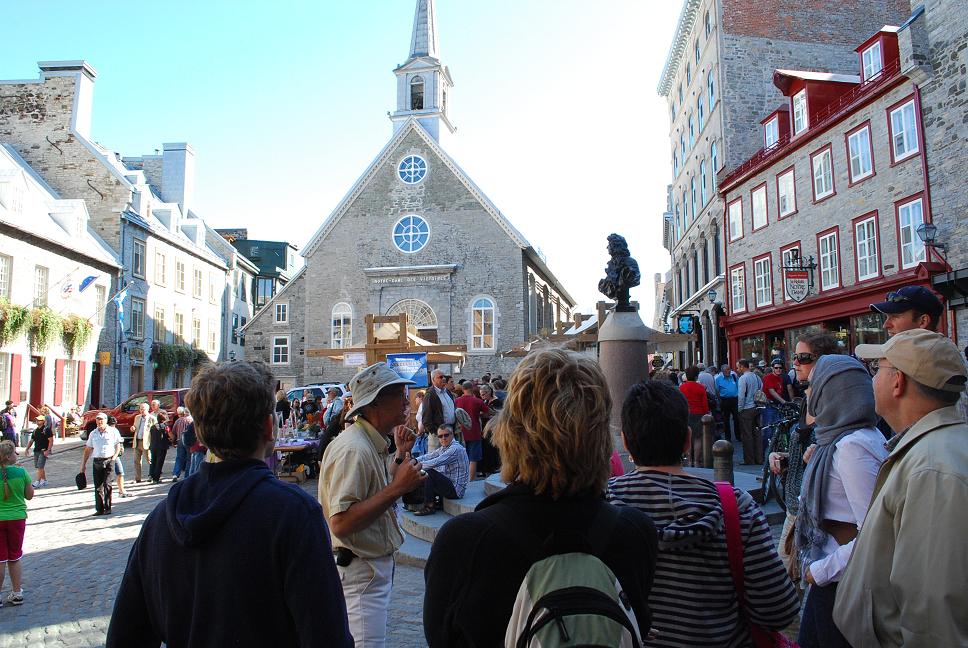The annual congress of the Société des musées québécois held from October 12 to 15 in Quebec City. Under the theme Museum and Intangible Heritage: Issues and Challenges , Congress has an opportunity to hear several speakers in the museum community, a workplace where it is practiced thousands of scientific history, come and present different problems facing the heritage immaterial. Could not attend the meetings, the holding of this congress is nevertheless a great opportunity to talk yet little about the role of the historian outside academia. And although, from a reliable source, the speakers of the congress did not really address the role of interpreter, we will try to talk a little more detail. A long post that is just the beginning of a longer discussion again ...
Source: A Guide Services Historic Six-Associés interpreting Charles Dickens at the Christmas visit in 2004-2005, in Old Quebec, near the park Cavalier du Moulin. (Photographer, Annie Boulanger). Archive Six Associates.
choices that arise According to the historian of the university are many. But we must admit that the historian who wishes to make history in the sense that he would call to study and understand the past, all outside the circles university, are not numerous. One of the best options is certainly looking for specialized firms. These companies exist and are numerous. This ticket does not address this option. This post deals with another option that may be interesting interpretation of history or more precisely the interpretation of heritage. We want here to distinguish between history and heritage. Indeed, the story is to say a study of the past through a scientific method by studying, comparing and linking a variety of sources is one thing. We are aware that this is a noble goal. But we do not believe can make the interpretation of history.

Source: "Freeman Tilden," U.S. National Park Service, online consultation , October 16, 2010.
Interpretation was first theorized by the American Freeman Tilden (above). Tilden is a journalist who publishes for the first time in 1957 a study that shows different rules of interpretation in his book Interpreting Our Heritage (University of North Carolina Press, 1957) following a request by the National Park Service of the United States. For purposes of this discussion, we chose to retain the definition of the International Council on Monuments and Sites which defines interpretation as follows:
"interpretation refers to all potential activities intended to increase public awareness and enhance understanding of the cultural heritage site. This may include publications, conferences, facilities on-site educational programs, community activities and research, training and ongoing evaluation of the interpretation process itself. " (from ICOMOS Charter for the interpretation and presentation of cultural and heritage sites, 2008, online consultation )
So, it is" to increase public awareness "by an exercise communication can become very complex. It therefore necessarily spell the academic sphere and research that need to be valid, a set of sources and arguments are presented and organized following a scientific method. Not that the interpretation does not meet its own rigorous methods and principles, this is simply not the same as the methods of the academic historian.

Source: François Poisson Barbarians Obliques Trois-Rivières present fear of the Tour de Trois-Rivieres (photographer, François Pilon), online consultation , October 16, 2010.
Thus, heritage alongside this world, but is motivated by other goals. objectives that are similar to those of interpretation. In fact, we accept the definition Consulting Group's policy of Quebec's heritage that defines heritage as "any object or [...] Overall, tangible or intangible, known collectively and appropriate for its value as evidence and historical memory and deserving of protection, preserved and enhanced " ( online consultation , p. 33) .

Source: François Poisson Barbarians Obliques Trois-Rivières present fear of the Tour de Trois-Rivieres (photographer, François Pilon), online consultation , October 16, 2010.
Thus, heritage alongside this world, but is motivated by other goals. objectives that are similar to those of interpretation. In fact, we accept the definition Consulting Group's policy of Quebec's heritage that defines heritage as "any object or [...] Overall, tangible or intangible, known collectively and appropriate for its value as evidence and historical memory and deserving of protection, preserved and enhanced " ( online consultation , p. 33) .

Source: The photograph presents a guide to the Stewart Museum Montreal featuring "The path of night owls", a guided tour in Snowshoe, online consultation , October 16, 2010.
It thus refers to an object that is "recognized", so that has already been studied on university benches, one refers to the value of "Truth and Historical Memory" which implies an emotional ownership by the public; and it refers to what should be "protected, preserved and enhanced" So a choice that is either public or political, organizational or because someone has decided that this past should be transmitted to future generations. In short, the action transmit (such as action to produce academic research in history for that matter) is never accidental.

Source: Guide See François Vidal towers Quebec Place Royale at the end of a tour of Old Quebec, online consultation , October 16, 2010.
Thus, university-trained historian will perhaps not be called a career. It must therefore find its niche. Is not given to everyone to begin to publish or to seek a satisfactory manner. And we must not hide the fact that knowledge of the past often takes the form of a passion among those who wish to pursue history. And interpretation of heritage is certainly a good option. The academic historian is well equipped to face the challenges of professional guide. Strong scientific method to read and understand the sources and historical materials, a sharp analytical mind. Only remains for him to gain experience in addressing the general public, nothing but a good background in animation can learn (understanding that it must also have the benefit of this knowledge to speak to the public) . But this area is ungrateful.
Few employers and organizations that recognize the true value of this work. First, it faces a major problem etymological guide, facilitator guide, interpreter, guide and interpreter, tour guide, hotel guide and facilitator are only a few concepts that will refer sometimes to the same reality, sometimes very different realities. And this, not to mention actors who do street theater history, drivers of taxis or horse drawn carriages that offer tours, guides school, other historians and scholars of the past become the guides for a stroll or conference, genealogists and many others!
We believe that the guide, whatever its form (either costumed historical figure or not, he plays a specific character or invented or that it simply presents itself as a guide) is an important transmission belt our past and our heritage more realistically (brief elements of our past that we wish to pass on to future generations). Who better than a person properly trained and competent to answer questions from visitors? Who better than a person present to hear the reactions of visitors to the content of exhibitions and visits to adjust the content to better meet the demands visitors? Who better to talk about intangible heritage, the things you can not see or even better, to help understand the evidence that these realities are immaterial? Who better to help create an experience "multisensory" that will be unforgettable? It is still present multimedia, interactive exhibition, the experience of feelings by manipulating objects or original works. But the guide would happen with good technical knowledge and could better meet the specific needs of visitors.
That several heritage sites and museums drop their own wage Guides misery, working conditions or outdated considering that this work should go only to volunteers or students minimum wage for summer is an absurdity. And too often the reality. ATTENTION: We believe that without volunteers, heritage institutions (and by extension cultural institutions at large) would sink into the abyss unfathomable and can not survive (the picture is a little strong, but nonetheless true). But it is especially true that the guides are a resource the less well exploited by many institutions.
We believe that the university-trained historian should broadly according to their desires and skills, integrated into the labor market positions guide. The historical method is a scientifically rigorous approach to the realities of the past and know how to take what is most significant. Thus prepared, these guides could become good belting to the public but also to other guides in their respective organizations. This would also ensure that historians continue to work in history, not as "creators of new knowledge, but as a purveyor or more appropriately, as" recovery "of our heritage. It's a different way of considering the work of the professional historian, but a real alternative to academia where, moreover, there are many called but few are chosen. To do this, we believe it is important to advocate for better working conditions for Guides in the broadest sense.
Our main suggestions for employers (and employees!):
* A respectful compensation based on academic training - a guide holding a bacc. or control and which is selected for these specific skills should never accept a salary equivalent to that of an employee in a position without training (we are aware that the reality of economics, supply and demand, is quite different. But it is crucial to actively campaigned for this in your workplace - museum organizations will perhaps stopped to ask why the coordinator's position at $ 13 an hour is vacant every six months ...)
Responsibilities * Research and development are intimately linked to the academic training to increase the feeling membership and retention of staff (for example, the guide formed in history is able to search and guide formed as an engineer animation may be more likely to find good ways to share this information)
* Respect for expertise in-house: if a guide is formed in history, he can benefit from its own research and reading the rest of the organization, including individuals who do historical research as a basic work.
* Focus on training: course content and classes of container. Keeping abreast of updated skills. Make available relevant scientific articles. Create informal groups of knowledge transfer. In short, professionalize this area of work.
It is certain that all organizations have different means. I'm talking about ideals that should be a priority. Deals with cultural heritage and increasingly diverse, it will take more than objects or multimedia or interactive stations to attract and retain your visitors. It will require trained guides, competent, dynamic and can just afford a level of interaction with much denser your sources and exhibits or tours that only objects or testimony. Historically, the guides were discarded in favor of content. It is time to ask questions ... We are aware that for many organizations, the reflection is still far from the situation ideal. But we propose to begin what will, hopefully, a profound change in the recognition of our past by giving chance to the real professionals it can continue to provide the closest possible knowledge of the scientific the best way possible.
Note: It should be noted that for the purposes of this note, we have deliberately left aside the notion of mediation or mediator who recently applied to the culture. Indeed, the mediator is a person who tries to bring the visitor a culturally defined (in our case wealth) using a together even more direct techniques that the only interpreter. Although the debate between interpretation and mediation is important to simplify a technical reading enough, we wanted to avoid additional definitions and thus approach the interpretation in the broadest sense.

0 comments:
Post a Comment